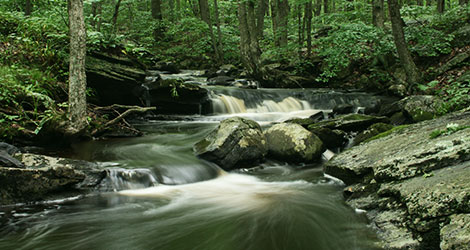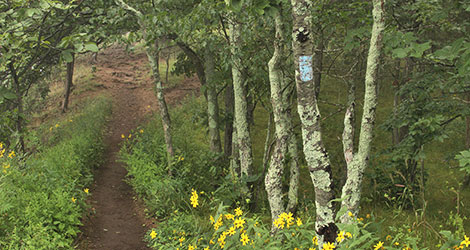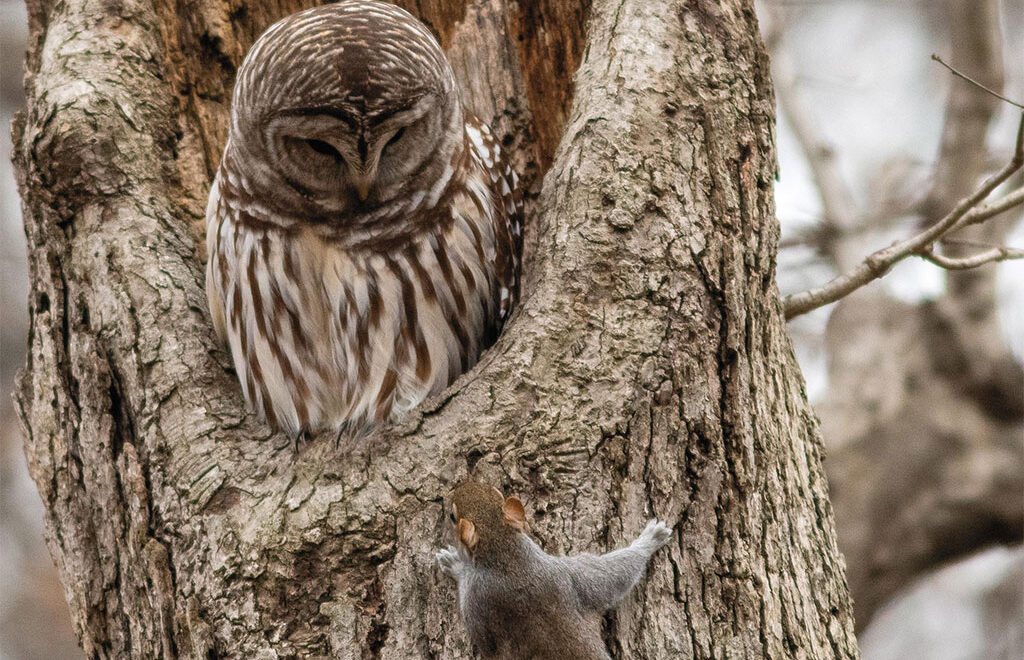
An Owl for All Seasons
Anytime is a good time to watch— and listen—for Connecticut’s most common owl.
By Laurie D. Morrissey
A soft whoosh overhead. A dark shadow sweeps through the dusky light. It seems to come out of nowhere, and it’s gone almost before I even register what it is. I’m sharing this woodland path with a Barred Owl, a nearly silent hunter than can detect the slightest rustle of a mouse—not to mention a bat, opossum, flying squirrel, or other small nocturnal creature. This owl is likely on the prowl for a meal to bring home to its nest, where one or two fluffy owlets await a fast-food delivery.
The Barred Owl is Connecticut’s most common owl, occurring here far more frequently than Great Horned, Eastern Screech, or Barn Owls. It differs from its relatives in several respects: it stays here year-round, frequents woodland edges and residential neighborhoods, and is not strictly “a night owl.” In the early morning or evening or in the middle of a cloudy day, it’s not unusual to spot this large, stocky figure perched on a low branch watching for unsuspecting prey.
This owl also makes its presence known by its distinctive call, a repeated “Who cooks for you? Who cooks for you-all?” It gives me a thrill no matter how often I hear it—a direct connection with the non-human world. Even better is hearing a pair of courting owls calling back and forth, a sound that carries a long distance on a still night.
While many bird species are in decline, including some owls, Barred Owls are holding steady or increasing. They prefer dense, moist woodlands, especially deciduous and mixed woods where they find cavities for nesting. But they often hunt closer to human habitation where rodents and small birds are plentiful. They’re also happy to eat big bugs that are attracted to outdoor lights and campfires.
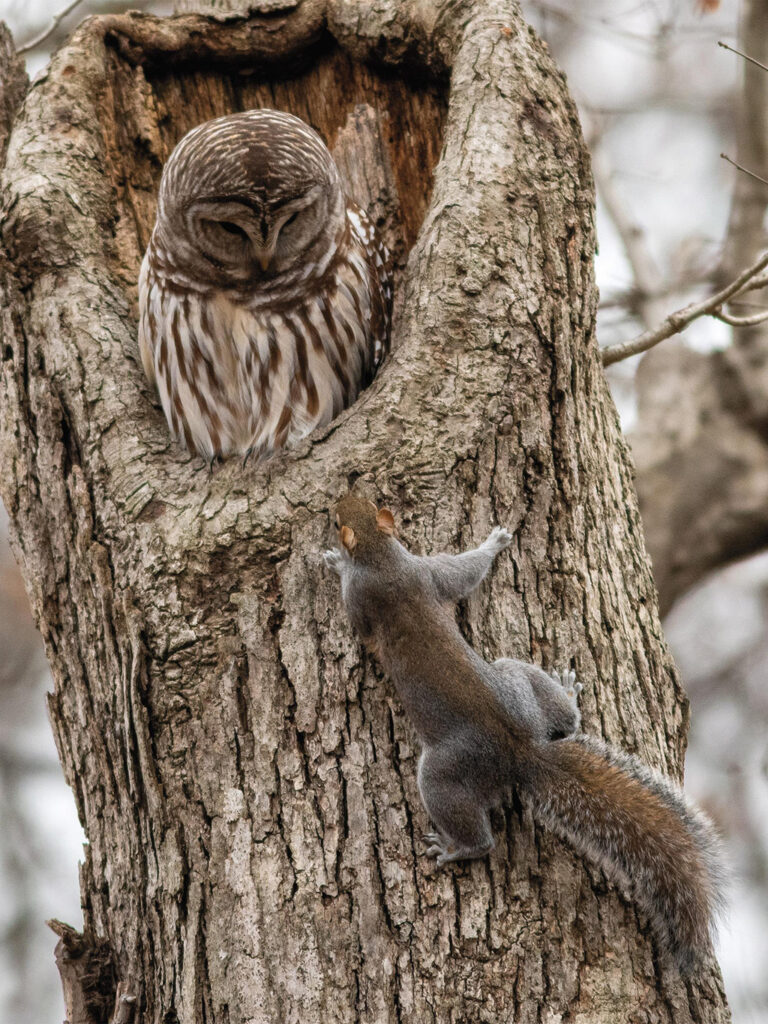
Photo by Sonny Nguonly
“Barred Owls are very adaptable to the suburban lifestyle,” explains Stefan Martin of Connecticut Audubon. “They’re generalists when it comes to diet. I’ve seen them at vernal pools in the middle of the day hopping around on logs catching frogs.” Eileen Fielding, center director at Sharon Audubon, recalls seeing a Barred Owl land on her deck railing in broad daylight and stare through the window at a small turtle in a tank. “Finally, the owl tried to pounce on it, but was foiled by the glass and gave up,” she says.
Barred Owls are 15 to 25 inches long, slightly smaller than Great Horned Owls and a foot longer than Screech Owls. The Barred Owl has a round, tuftless head, brown and white feathers, and a light facial disc with dark eyes. Its legs and parts of its toes are covered in feathers. Both male and female have a mostly white breast with vertical brown streaks, and horizontal brown markings on the upper neck and chest. Females are as much as a third larger than males, with a wingspan of up to four feet.
Fielding observes Barred Owls in the wild and has worked with them as a wildlife rehabilitator. “I always keep an eye out for them when I’m in damp woods or on the edge of a wetland, especially if there are large cavity trees around,” she says. “I hear more Barred Owls than any others, and their calls are by far the most fun to hear. A lot of people are familiar with their Who cooks for you-all, but they also get into raucous back-and-forth Whoo-aa! Aw-aw-aw! shouting matches that sound like a troop of monkeys has invaded the woods.”
At the Sharon Audubon Center, Fielding uses non-releasable owls (who have healed from severe injury) as “ambassador birds,” giving her opportunities to observe their behavior. “They’re easy birds to work with, and as young birds, they’re curious and playful. I’ve seen them playing with toys, picking them up and manipulating them with their feet and beaks.”
Connecticut’s Barred Owls begin courting in late winter and lay two or three eggs in April and May. The chicks hatch in about 30 days, looking like downy white puffballs and begging for food in a raspy buzz. In 4 to 8 weeks, they make their way out of the nest and exhibit a behavior called “branching.” They clamber around in their nest trees, flapping their wings to keep their balance. If they drop to the ground, they climb back up the trunk using their bills and talons.
It is a myth that owls can completely rotate their heads, but they can turn them 270 degrees in either direction and 90 degrees up and down.

Photo by Pat Miller
Owls are not good fliers until they are about three months old. To keep their increasingly loud, screechy youngsters’ bellies full, the parents need to hunt during daylight. “I get a ton of emails from people asking if the sound they’re hearing a bobcat or a fisher,” says Martin. People also ask what to do when they find a baby owl on the ground. “If it’s still in the downy stage, it might need the help of a rehabilitator. If it’s feathered, it’s just fine. It just needs to find its way to a safe place, and it’s important to keep dogs away.”
One of the most fascinating things about Barred Owls is their adaptations for hunting. Highly specialized wing shape and feather structure, and large wings relative to their body mass, allow them to fly unusually slowly with little noise-producing flapping. The feathers around their facial discs direct sound to their ears, and their large eyes work efficiently in low light. Their eyes face forward and are fixed in their sockets. To look right or left, owls must turn their heads. It is a myth that owls can completely rotate their heads, but they can turn them 270 degrees in either direction and 90 degrees up and down thanks to highly mobile necks. Owls have twice as many vertebrae in their necks as humans do.
A good way to appreciate these amazing birds up close is to visit a wildlife facility such as White Memorial Conservation Center in Litchfield, home to two Barred Owls, Shakespeare and Ophelia. Some centers offer guided night hikes for viewing nocturnal wildlife. Bright nights are optimal, since moonlight makes owls more active, as well as easier to see. You can also increase your chances of encountering these owls by understanding their needs and habits. Barred owls return to their nesting sites year after year, and disgorged pellets on the ground under a tree can signal their presence. You can also place a nest box near the edge of your yard. But whether you’re lucky enough to see one, you’ll likely hear it asking: “Who cooks for you?”
Laurie D. Morrissey is a New Hampshire based writer whose work has appeared in Connecticut Woodlands since 2016. She has also been published in Northern Woodlands, Art New England, New Hampshire Home, Appalachia, and numerous poetry journals.
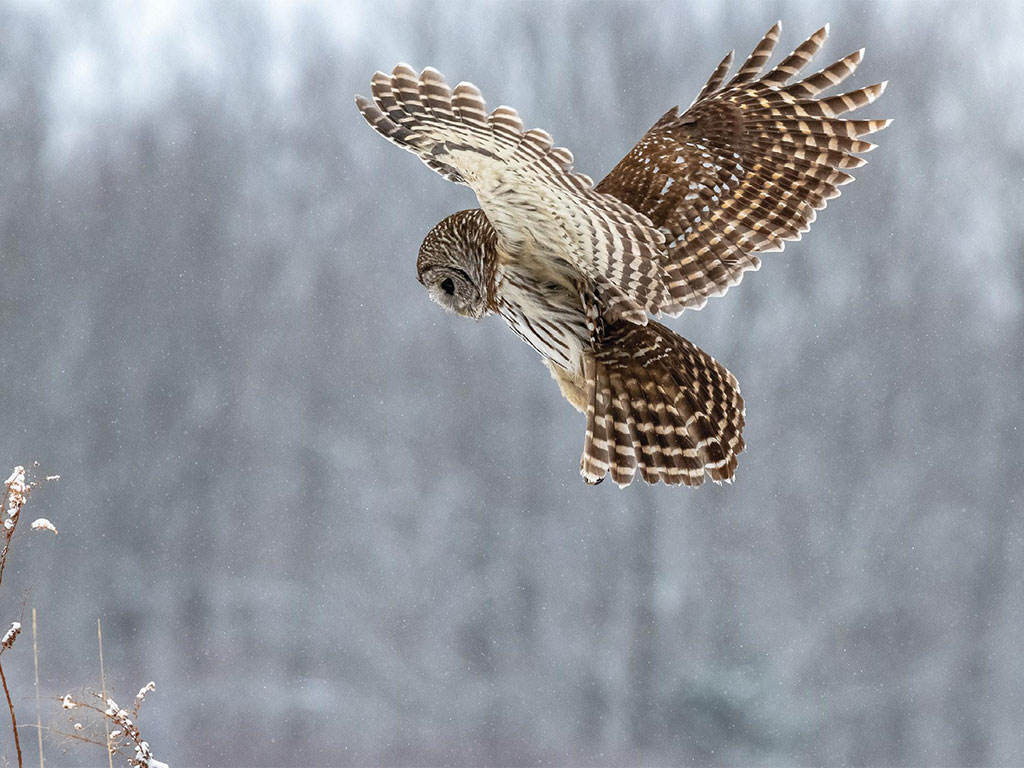
Photo by Dale Monette
“They also get into raucous shouting matches that sound like a troop of monkeys has invaded the woods.”
Eileen Fielding
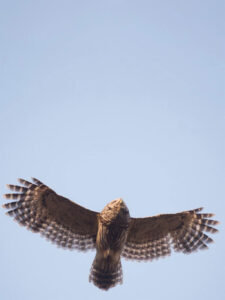
Connecticut’s Barred Owl Boom
In the winter of 2019, Barred Owls were seen perching atop garden furniture, farm equipment, and bird feeders. Biologists call this kind of sudden population boom an irruption. The cause of the 2019 increase is not clear, says UConn professor Chris Elphick. It may have been caused by a very successful breeding season followed by food scarcity. If the food supply was low, the birds had to hunt further, and at different hours. “This year seems pretty normal,” Elphick says. “2019 is the only time I’ve seen anything like an irruption happen in this species.”
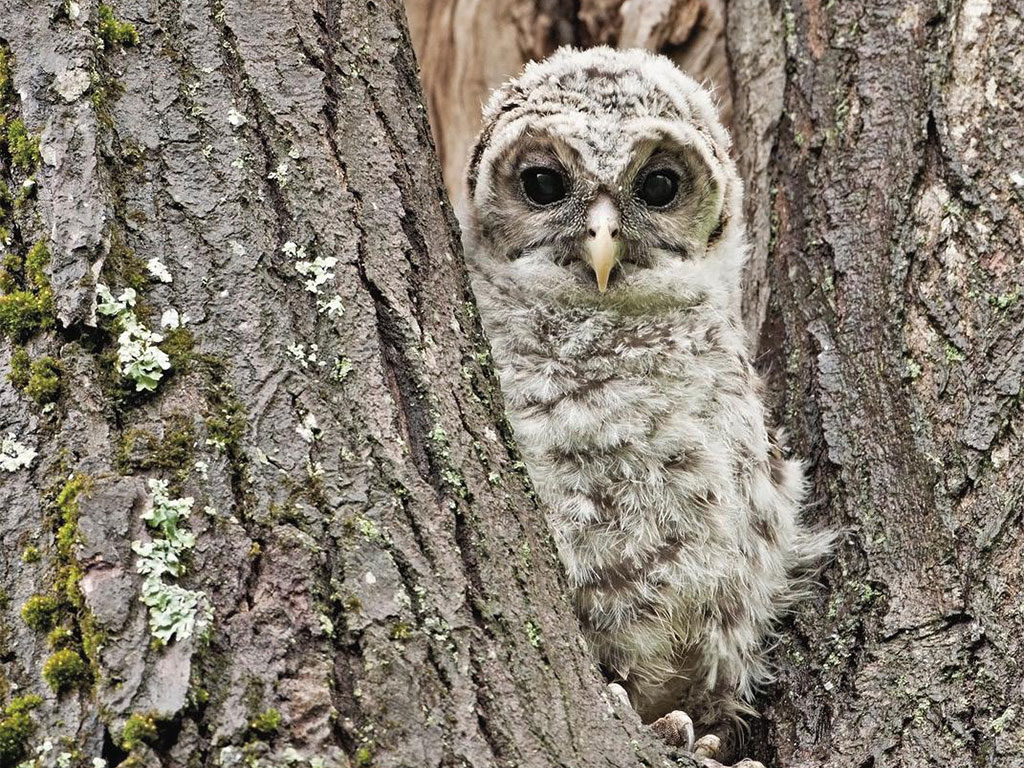
Photo by Mark S. Szantyr

